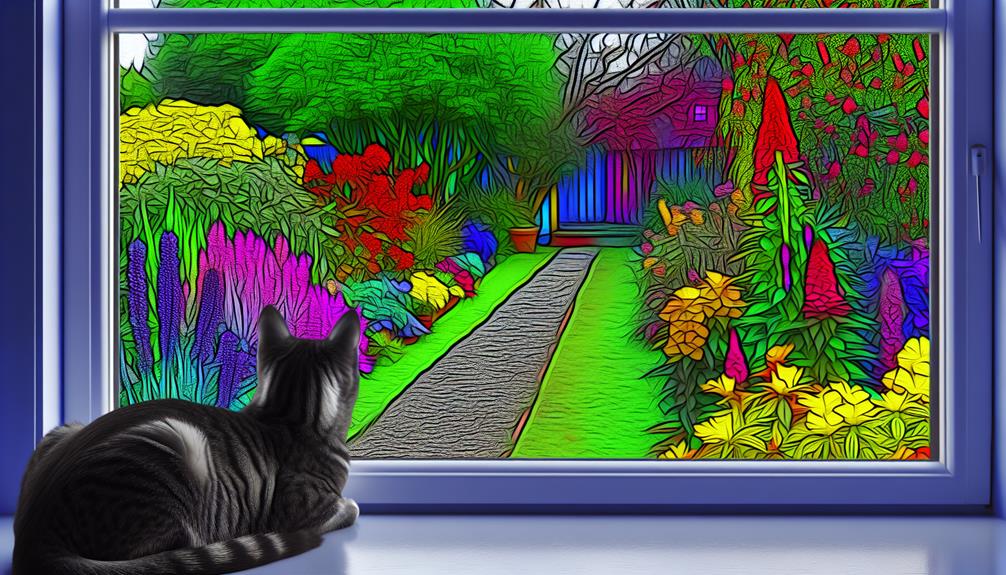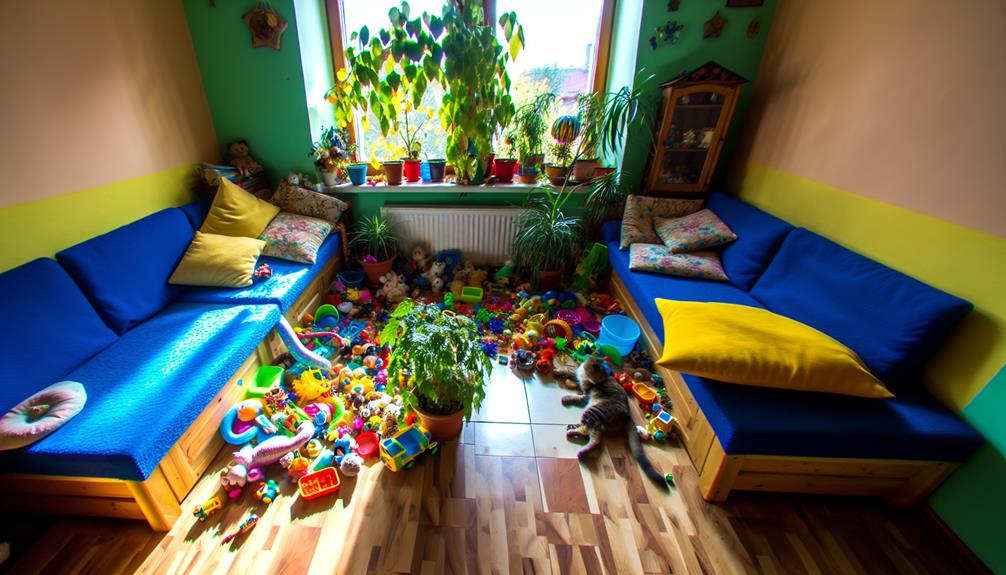Imagine seeing the world through a softened, two-toned lens, where the vibrant hues you know fade into muted shades. Cats experience this every day due to their dichromatic vision, which limits their color perception to mostly blues and greens. They don't see reds and pinks as you do; instead, these colors appear more like grays or browns to them. This unique vision affects how they interact with their surroundings. Curious about how this influences their behavior and the way they navigate their environment? Let's explore further.
The Science of Cat Vision
When delving into the science of cat vision, it is important to understand the anatomical and physiological differences between feline and human eyes. You'll find that one of the most notable distinctions lies in the structure and function of the retina. In cats, the retina contains a higher density of rod cells compared to cone cells. Rod cells are highly sensitive to low light conditions, thereby enhancing night vision. This adaptation allows cats to detect even the slightest movement in near-darkness.
Additionally, the feline perception of their environment is influenced by the tapetum lucidum, a reflective layer located behind the retina. This structure acts as a mirror, reflecting incoming light back through the retina, thereby amplifying the available light and greatly improving their ability to see in dim conditions. Because of this, you might notice that a cat's eyes often appear to glow when light is shined on them at night.
Moreover, the overall field of vision in cats is wider than that of humans, encompassing approximately 200 degrees compared to a human's 180 degrees. This broader field of vision is important for detecting peripheral movement, which is essential for both predation and avoiding potential threats. However, it's important to note that this enhanced night vision and motion detection come at a cost. Cats have fewer cone cells, limiting their ability to perceive fine details and color.
Understanding these differences in feline perception is fundamental when exploring how cats interact with their environment, especially under low-light conditions. Their specialized vision is a remarkable evolutionary adaptation, optimized for survival and efficiency in their natural habitats.
Colors Cats Can See
Cats' unique visual system greatly influences their color perception. Unlike humans, who possess three types of cone cells for detecting a wide range of colors, cats have only two types of cone cells. This dichromatic vision limits their color perception, rendering their visual world less vibrant and more muted.
Feline eyesight operates effectively within a specific range of the color spectrum. Cats can distinguish between shades of blue and green, but their ability to perceive red and pink is limited. This means that while you might see a bright red ball, your cat might perceive it as a shade of gray or brown. Studies indicate that cats' color perception is akin to that of a human with red-green color blindness.
Key points to take into account about the colors cats can see:
- Blues and Greens: Cats can differentiate shades of blue and green quite well.
- Limited Reds and Pinks: These colors are less distinguishable, often appearing as grayish or brownish hues.
- Yellow Spectrum: Cats can perceive some shades of yellow, though not as vividly as humans do.
The structure of feline eyesight, particularly the types of photoreceptor cells in their retinas, dictates these limitations. Cats' rod cells, which are more numerous than their cone cells, are highly sensitive to low light. This adaptation allows for superior night vision at the cost of a richer color palette.
Understanding these aspects of feline color perception is essential for appreciating how cats interpret their environment. Their world is defined more by contrasts and movement than by the vibrant spectrum of colors that humans experience. This nuanced understanding of feline eyesight enables better interactions and enriches the bond between you and your cat.
Colors Cats Can't See

The limitations of feline color vision result in certain colors being beyond their perceptual capabilities. Cats possess a dichromatic vision system, meaning their retinas contain two types of cone photoreceptors sensitive to different wavelengths of light. This dichromatic system is less complex compared to the trichromatic vision in humans, who have three types of cones. As a result, the feline color perception is limited, and they can't distinguish certain colors within the visual spectrum.
Specifically, cats lack cones sensitive to long wavelengths, which are responsible for red detection in humans. Consequently, reds, oranges, and related hues appear as shades of gray or brown to cats. Additionally, colors in the green spectrum may not be as vivid for cats because their vision primarily focuses on blue and green wavelengths. This diminished differentiation leads to a color palette that is muted and less varied.
In contrast, cats can perceive some shades of blue and green, but they can't see the full spectrum of these colors as humans do. Their vision skews towards the blue end of the visual spectrum. Thus, the absence of sensitivity to long wavelengths fundamentally alters the way cats interact with their environment through color perception.
Understanding these limitations is essential for comprehending how cats perceive their surroundings. This restricted range of color vision emphasizes that while cats are adept at detecting motion and seeing in low light, their ability to differentiate colors is notably compromised. These perceptual constraints shape their behavioral and navigational strategies, offering insights into the adaptive nature of feline vision.
How Cats Use Color
Feline perception of color, though limited, plays a essential role in their daily interactions and survival strategies. Cats' color perception is not as broad as humans', but they can distinguish certain hues, particularly in the blue and green spectrums. This ability influences their hunting, social behavior, and environmental navigation.
Cats utilize their color perception for various practical purposes:
- Locating Prey: While cats primarily depend on movement detection and sharp night vision, the ability to discern specific colors can help them identify prey in varied environments. Green and blue hues contrast against natural backgrounds, aiding in spotting small animals.
- Social Interactions: Cats might use color to recognize other cats or objects within their territory. Visual preferences for certain colors could play a role in identifying familiar individuals or landmarks, facilitating social bonding and territorial management.
- Environmental Adaptation: Cats' limited color vision can help them better adapt to their surroundings. By differentiating between the blue and green hues of vegetation and the duller shades of the ground or obstacles, they navigate efficiently, avoiding potential hazards.
Understanding how cats use color perception can be helpful in optimizing their living conditions. However, it is important to remember that their reliance on color is secondary to other senses such as smell and hearing. When observing their behavior, you'll notice that while they don't react to colors as vibrantly as humans do, their ability to perceive certain hues still contributes considerably to their interaction with the world. This nuanced understanding of feline color vision enriches our appreciation of their intricate sensory world.
Enhancing Your Cat's Environment

Enhancing your cat's environment can greatly improve its well-being by catering to its sensory and behavioral needs. One way to start is by considering the placement and type of cat furniture. Items such as scratching posts, climbing trees, and cozy beds provide essential outlets for your cat's natural behaviors. Play areas equipped with interactive toys can stimulate your cat's hunting instincts and keep it mentally engaged.
Natural lighting is another critical factor. Position window perches to allow your cat to bask in sunlight and observe outdoor activities. This not only offers sensory stimulation but also guarantees your cat receives sufficient vitamin D.
When it comes to wall colors, opt for shades that are within a cat's visual spectrum—blues and greens. These colors can create a soothing environment that aligns with how cats perceive the world. Additionally, integrate greenery options such as cat-safe plants to enrich your cat's sensory experience. Plants like catnip and wheatgrass can be particularly beneficial.
Here's a table to summarize these enhancements:
| Aspect | Details | Benefits |
|---|---|---|
| Cat Furniture | Scratching posts, climbing trees, beds | Behavioral satisfaction, comfort |
| Play Areas | Interactive toys, designated play zones | Mental engagement, physical activity |
| Window Perches | Placed in sunlit areas, with outdoor views | Sensory stimulation, vitamin D intake |
| Wall Colors | Blues and greens | Visual harmony, calming environment |
| Greenery Options | Catnip, wheatgrass, other cat-safe plants | Sensory enrichment, natural interest |
Conclusion
So, while you might be reveling in the vibrant spectrum of a rainbow, your cat sees a world that's more muted, relying on contrasts and motion. Ironically, your feline friend, the epitome of grace and agility, navigates an environment where reds are gray and yellows are dull. Yet, despite their limited color vision, cats possess a perceptual prowess that's perfectly tuned for survival. Maybe it's you who's missing out on seeing the world through a cat's eyes.
